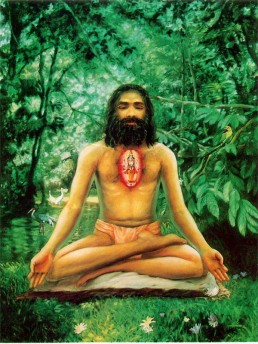Whereas the previous stanza gives us a relative estimate of the different paths in spirituality, and finally declares that meditation is the best among the lot, the stanza now under review explains who exactly is the best among all the meditators. Meditation is, in the beginning at least, a deliberate act by which the seeker strives to keep his thoughts channelised into one pre-determined divine line of thinking; and this is maintained by disallowing the mind to run into dissimilar thought-channels. Meditation, therefore, must of necessity start with an effort on the part of the meditator to fix his mind upon some object of contemplation.
The Art of Meditation can be classified under different types, according to the nature of the object of contemplation chosen and according to the nature of the persuasions adopted in curtailing the mind from its mad roamings. Thus we have, in the tradition of our practices, meditations prescribed upon a symbol, on the God-principle with a form, on the teacher, on the Kundalini, on any of the great elements, or on a chosen scriptural text. Accordingly, the practitioners may be considered as followers of different kinds of meditation. The Singer of the Geeta is trying to indicate here, who exactly is to be considered as the best and the most successful meditator among the types mentioned above.
In this concluding stanza of the chapter, the Lord insists that of all the meditators, he who “WITH HIS INNER-SELF (MIND-AND-INTELLECT) MERGED IN THE SELF, AND WITH ‘SHRADDHA’ DEVOTES HIMSELF TO THE SELF, IS THE MOST FIRM AND STEADFAST MEDITATOR.” The pregnant suggestions contained in this stanza can fill volumes, inasmuch as it is a summary of the entire Yoga Shastra. Naturally therefore, Lord Krishna dedicates the entire length of the next chapter as an annotation to this mantra-like stanza.
For the purpose of our understanding this chapter, it is sufficient for the time-being if we gather from this stanza that the essence of meditation is not so much in our attempt at integrating the mind as in the ultimate merging of the inner equipment (Antahkarana), and getting it completely sublimated in the final experience of the Self. That, this can be done only by one who does proper Bhajana upon the Self with all Shraddha, is the truth-declaration made here with a loving insistence by the Eternal Lover of the gopis.
The term Bhajana has come to gather to itself such a lot of adventitious superstitions that, as it is understood today, it means elaborate rituals, which, almost always, mean nothing to the priest, nor to the devotees who are mere onlookers of the priestly performances. Sometimes it means a lot of loud singing with noisy accompaniments, and an entire crowd roaring away on their march towards an emotional ecstasy, and often, each session ending in hysteria and exhaustion. Very rarely do they gain even a vague experience of the spiritual thrill. In the Vedantic text-books, Bhajana is “the attempt of the ego to pour itself out” in an act of devoted dedication towards the Principle of Reality, whereby the devoted personality successfully invokes the experience that lies beyond the noisy shores of the mind-intellect equipment. One who does this invocation (Bhajana) of the Self, and naturally gets himself merged in that awakening, is declared here by the teacher of the Geeta, as belonging to the highest type of meditation.
It is quite evident to every student of Vedanta that such a meditator comes to transcend all his identifications with the false matter-envelopments, and becomes, through the experience of his Real Nature, the very Self.
Yet, the mouth-piece of renascent Hinduism, Lord Krishna, in his modesty and reverence for the tradition in our culture, attributes this statement in the stanza to his own personal opinion.

